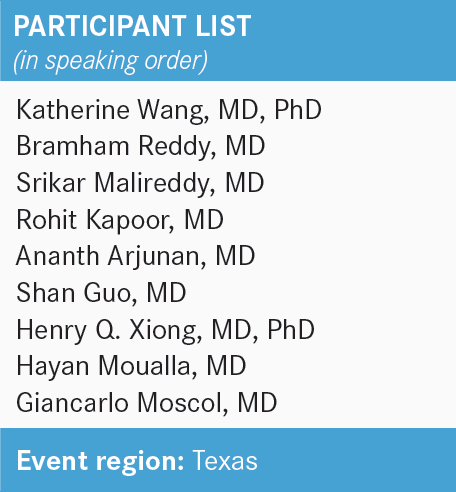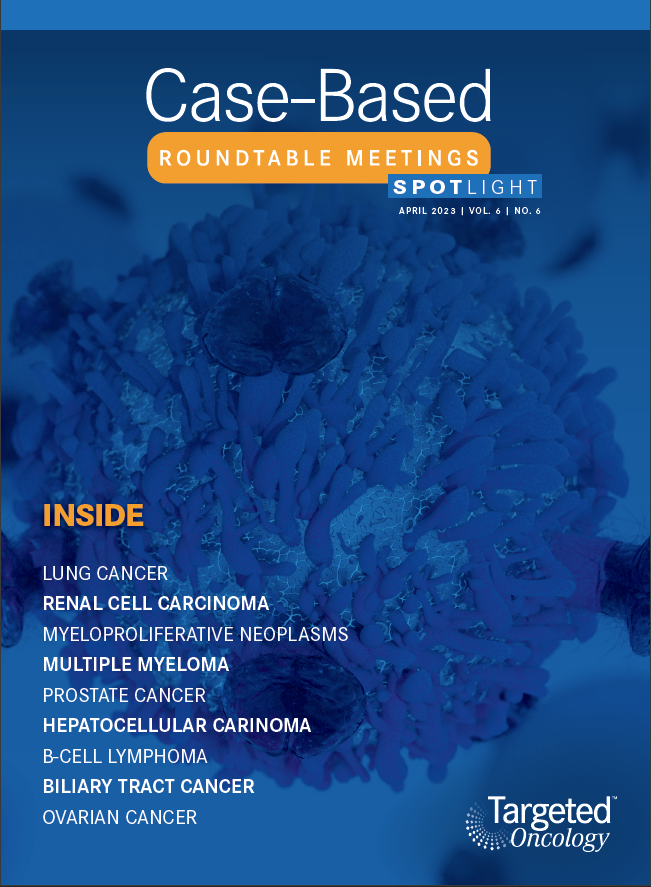Roundtable Discussion: Singal and Participants Debate Biopsy and Adverse Events for Patients With HCC
During a Targeted Oncology™ Case-Based Roundtable™ event, Amit Singal, MD, discussed next steps for a patient with a LI-RADS 5 hepatic mass who has cirrhosis, Crohn disease, and a history of variceal bleeding.
Amit Singal, MD
Medical Director, Liver Tumor Program
Clinical Chief of Hepatology
UT Southwestern Medical Center
Dallas, TX


CASE SUMMARY
A 77-year-old White woman presented to her primary care physician with abdominal pain and fatigue. She had a history of cirrhosis due to heavy alcohol use; Crohn disease controlled with infliximab-axxq (Avsola); and a history of variceal bleeding, with banding 2 months ago. Her ECOG performance status was 1. A CT scan of her chest, abdomen, and pelvis with triphasic liver evaluation showed 4.5-cm, Liver Reporting and Data System (LI-RADS) 5 hepatic mass in the right lobe, plus metastatic disease in the lung. She had a Child-Pugh score of A and α-fetoprotein level of 380 ng/mL.

SINGAL: [Most] respondents—[approximately] 75%—would not recommend a biopsy at this point, and [approximately] 25% would recommend a biopsy. Can one of the [panelists] who would recommend a biopsy say why you would do a biopsy in this case?
WANG: I chose to biopsy. I know this patient has a high risk of bleeding, but her presentation is that she has liver and lung involvement, so I’m not sure. Her AFP [α-fetoprotein] was 380 ng/mL, [and] you usually see AFP in the thousands for a patient with typical HCC, so that’s why I chose to biopsy.
REDDY: I said no, but I’m thinking about whether MRI is more standard than CT to give confirmatory imaging. The other thing was, when some insurances are [asked for] approval for 2 very expensive drugs, I’m not sure they’re going to buy a diagnosis of this patient made with a CT scan [and] not an MRI.
MALIREDDY: I chose not to biopsy based on the 2 dynamic imaging studies and the AFP [being] more than 200 ng/mL. I think it used to be [200 ng/mL in older guidelines] lines, so if you have a patient with cirrhosis and they have a mass [suggesting hepatocellular carcinoma (HCC)] on 2 dynamic imaging studies with AFP of more than 200 ng/mL, biopsy probably is not necessary. Recently, the levels have changed in the AASLD [American Association for the Study of Liver Diseases] guidelines for the diagnosis of HCC, right?1
SINGAL: That’s exactly right. This patient has a history of cirrhosis. We saw the imaging, which was a triphasic CT in this case, and it has a LI-RADS 5 lesion, so it presumably has arterial phase hyperenhancement and delayed washout on the triphasic CT scan.
This question of CT scan vs MRI is a valid one. Both CT scan and MRI are acceptable. The MRI does have a higher sensitivity than the CT scan, so if you can get either one—I personally think a good-quality MRI is better than a good-quality CT scan. That being said, if you have a good-quality CT scan and you have characteristic appearance, this does not mean you have to get an MRI [or] a biopsy. The positive predictive value for that imaging appearance of LI-RADS 5 is [approximately] 95% to 97%.
DISCUSSION QUESTION
- What is the role of AFP for this patient?
SINGAL: During this discussion, we talked about the AFP levels. The AFP levels used to be part of the diagnostic criteria. This cutoff of 200 ng/mL—it used to be 200 vs 400 ng/mL—[was] the criteria that would be considered for diagnosis of HCC. But more recently, the guidelines have removed that from the diagnostic criteria, given both poor sensitivity and specificity.
The AFP sensitivity, in terms of diagnostic criteria, is only [approximately] 50%. We see many HCC cases where you can even have normal AFP levels, despite having metastatic disease or vascular invasion. We know AFP can be elevated in the setting of mixed tumors, or even cholangiocarcinoma itself. So AFP is not part of the diagnostic algorithm, but it is important that if somebody has characteristic imaging, you don’t need to do a biopsy to get approvals for systemic therapy. To that point, we have patients who have characteristic imaging who then go on to liver transplantation without a biopsy, so this imaging is sufficient for any type of treatment and typically does not preclude insurance approval for treatment.
KAPOOR: What about the biopsy on the lung metastasis? Is that necessary?
SINGAL: The difficult thing about these cases is it always depends on what the imaging looks like. I would argue that if the imaging was definite for metastases, then I don’t think a biopsy of those lesions would necessarily change your clinical management. You would still treat it as metastatic disease.
The time we consider a biopsy of potential metastasis, for example, is if we’ve seen a patient who has an adrenal lesion or has a lymph node and we’re unsure [whether] that patient has metastatic disease—and that’s particularly if the lesion is small [and] there’s a clinical question [of whether] this is metastatic disease—then we may pursue a biopsy to confirm metastatic disease. [However], if the imaging, once again, shows a large [lung] lesion, what appears to be definite metastases, you do not need to pursue a biopsy of the metastases.
KAPOOR: If you look at the [National Comprehensive Cancer Network] guidelines, they recommend doing a biopsy if not previously done for the metastatic lesion.2
SINGAL: How would that change your management?
KAPOOR: [If the patient was going to receive] transplant vs no transplant.
SINGAL: This is where, if it’s definite metastatic disease, that would not change your clinical management of transplant vs no transplant. But if there’s any question, then it would be worthwhile to prove metastatic disease. That’s where it comes into the pretest probability of this. It’s always worthwhile considering a biopsy, but the question is [whether] you would perform it, [which] depends on your pretest probability. If your pretest probability is sufficiently high, then the biopsy presumably would not change your management. Even if it’s negative, you’re going to say it’s a false negative rather than changing your direct management. If your pretest probability is somewhere in the middle, that’s where the biopsy is very helpful. If your pretest probability is low, it sometimes can help in terms of proving it is a nonmetastatic lesion, to then proceed with transplant.
[However], for example, if you have an infiltrative disease in the liver, or you have a 10-cm lesion and a 2-cm nodule on the adrenal gland, that’s a different scenario where you would have a high pretest probability. Biopsy of that lesion would be unlikely to change your clinical management. We have seen a change in our perspective, in terms of pursuing biopsies looking for targetable mutations and other things, so I’m not saying you can’t do a biopsy. I think the question is: Do you need to do a biopsy? I would argue [that] if you do not need to do a biopsy to confirm diagnosis, you may consider it for other reasons.
Two years ago, this was an easy discussion, because the [practice of the] field at that time was not to do a biopsy. As we’ve seen more therapies come around and we’ve seen our perspective change, we’re currently in this gray zone in terms of how we approach this question, so this is one where our thinking is evolving over time. Even the AASLD guidelines, which are currently being revised, will come around and say a biopsy can be considered in these cases with definite HCC— not so much for diagnostic confirmation, but for looking at targetable mutations.1
DISCUSSION QUESTION
- Would your use of biopsy be different if the patient did not have cirrhosis? Would it differ if the lesion was LI-RADS 4?
ARJUNAN: I’d be more interested in getting the biopsy done, to your point about pretest probability.
SINGAL: The guidelines say [that] in the absence of cirrhosis—even if you see a lesion that has a characteristic appearance, arterial phase hyperenhancement, [and] delayed washout—pretest probability is more in the intermediate ground, and we would 100% pursue a biopsy. It can help rule out other things that can mimic this, [such as] neuroendocrine tumors, which would be treated very differently. In the absence of cirrhosis, it would be important to consider a biopsy for histologic confirmation so we know what we would be treating.
Assuming the biopsy was obtained and confirmed HCC, would anyone recommend any further genetic analyses of the biopsy tissue?
ARJUNAN: I would do it because it’s fairly easy to get done nowadays, but I wouldn’t expect many actionable mutations. Most of the driver mutations are things like ARID1A and TERT, which are not [actionable] targets. [However], it would be an academic exercise and perhaps relevant for future clinical trials.
GUO: I would do the same, in case there is anything. I wouldn’t expect much, but I’m always curious to see what the PD-L1 level is so I can try to predict. I know that’s not a prognostic, predictive marker, but I still would like to know, in addition to the next-generation sequencing.
KAPOOR: I’d like to know the MSI [microsatellite instability]-high and FGFR status.
SINGAL: It’s interesting. I think many of us do this, and the way it was described is probably accurate. It’s easy enough these days to get it, the costs have come down, etc. It’s easier on us. The sentiment of not expecting much is probably accurate. This is our practice as well, to send it for many patients, although we do so [without] expecting an actionable mutation in many patients.
The PD-L1 status is interesting because although it can be predictive in other cancers, it has not been found to be predictive of IO [immunotherapy] response in HCC. Same with the MSI-high: Although [it is] predictive for IO response, it is relatively uncommon in HCC. [With] that said, uncommon is not 0, so it’s the type of thing where it’s always nice [to expect a better response] for those few patients in whom we find it…. The FGFR is also another interesting mutation to look out for. So these are things we can do and this is an evolution in terms of our changing clinical practice as we approach these patients for systemic therapies.

DISCUSSION QUESTIONS
- How do the toxicity profiles of lenvatinib and sorafenib differ as used for unresectable HCC?
- What is your approach to adverse event prevention, monitoring, and management with each of these agents?
SINGAL: When we think through the toxicities between lenvatinib [Lenvima] and sorafenib [Nexavar], we can look at the common adverse events [AEs] in the REFLECT [NCT01761266] trial.3 Lenvatinib had fewer hand-foot syndrome events compared with sorafenib, but [it] has more hypertension, more loss of appetite, and more weight loss. How does this compare with your clinical practice when you think of your experience with lenvatinib and sorafenib? Do you see these toxicity profiles of the therapies in your clinical practice, or is this different from what you see? And what strategies have you implemented in terms of AE management?
MALIREDDY: We used to use [sorafenib] in the past. We used to see a lot of hand-foot syndrome, diarrhea, [and] maybe a bit of hypertension, but not the weight loss. With lenvatinib, you educate the patient about all the AEs nowadays. As soon as they come up with the AEs, we can hold the medication and then decrease the doses pretty rapidly for those patients.
XIONG: What [wasn’t mentioned] is the level of fatigue. Patients taking lenvatinib seem to have more fatigue than patients taking sorafenib, so that’s the AE that’s not easy to deal with. Hypertension doesn’t scare me. Diarrhea—sometimes, yes—but still manageable. But we don’t have a medicine for fatigue, [which] bothers a lot of people.
SINGAL: I completely agree. I have to say that I find it nice to have less hand-foot syndrome events. I think that’s definitely less with lenvatinib compared with sorafenib. But I agree that I do sometimes have trouble with this general fatigue, loss of appetite, and weight loss. Those can sometimes be more difficult to manage than some of the others. I agree with you, the hypertension and diarrhea in some cases can be tough. But in most cases, they’re quite manageable [if] you monitor [them] and tackle them early.
DISCUSSION QUESTIONS
- Were you familiar with the data for single-agent lenvatinib in the LEAP-002 (NCT03713593) arm?
- What are your reactions?
- Discuss the selection of lenvatinib for this patient and your own experiences with lenvatinib in this setting.
SINGAL: I don’t know how familiar people were with the LEAP-002 data.4 What are your reactions? I think the lenvatinib monotherapy arm is particularly relevant, because that is the one that will continue to be available in our clinical practice.
XIONG: The trial showed that lenvatinib is a good drug. Just like in the beginning, when sorafenib was approved, I said, “Wow, that’s not much activity.” But throughout the years, sorafenib earned my respect, because too many agents tried to beat sorafenib and failed. I see that [with] lenvatinib; it’s going to be something. Let’s say there’s another regimen that was just approved, like tremelimumab [Imjudo]—if you use the tremelimumab regimen and compare with lenvatinib, I don’t think the [tremelimumab] regimen has a chance.
SINGAL: The funny thing is most people argue that in LEAP-002, if the comparator arm was sorafenib, we would see lenvatinib/pembrolizumab [Keytruda] approved right now.
XIONG: Yes, approved in no time. But that’s why I say if it’s tremelimumab compared with lenvatinib, tremelimumab will fail.
SINGAL: You may be right there. Lenvatinib is clearly a potent medication and can achieve long survivals in patients.
MOUALLA: I would have expected lenvatinib/pembrolizumab to perform better.
MOSCOL: Sometimes with IO, you can get a more prolonged progression-free survival [PFS] on the subsequent line of treatment. Are they following that on the pembrolizumab arm, for example?
SINGAL: I don’t know how far out they’re going to follow [patients] at this point. The PFS was not significantly different between the 2 arms.4
KAPOOR: The results were surprising because for a year or 2, when nivolumab [Opdivo] was introduced into the treatment of HCC, it seemed intuitive that it would be additive to a TKI [tyrosine kinase inhibitor]. I think the LEAP-002 study was surprising.
SINGAL: I think the sentiments that have been described parallel my thoughts and the thoughts of others in the field— surprising. Many of us recognize the combination of lenvatinib and pembrolizumab as a potent combination. When you take a look at how lenvatinib/pembrolizumab did, it performed as it should.
The median overall survival was 21.2 months, [which is] very similar to what we saw in the phase 2 data.4 This is one of those trials where its failure was not necessarily the agent or the combination not performing, but [rather] the comparator arm doing surprisingly better than one would expect.
This is probably a combination of subsequent lines of therapy. Patients going on to IO, if not IO combinations, in the second line. Also, because this was a double-blind, placebo-controlled trial, there were a lot of efforts to keep [patients] on therapy. The duration of lenvatinib monotherapy was longer than what we’ve seen in other studies, so I think some of the management of the lenvatinib arm was aggressive, in terms of keeping [patients] on and maximizing the benefits.
One of the lessons I’ve taken away from this is if we choose to start someone on lenvatinib or TKI therapy, we should be very aggressive with AE management, patient education, trying to keep [patients] on therapy, etc. If we do that, we can achieve these long survivals—if we’re able to keep them on and get them to subsequent lines of therapy when appropriate.
REFERENCES
Management of hepatocellular carcinoma. American Association for the Study of Liver Diseases. Accessed March 14, 2023. https://bit. ly/42eHqs6
NCCN. Clinical Practice Guidelines in Oncology. Hepatobiliary cancers, version 1.2023. Accessed March 14, 2023. https://bit.ly/404Uyyq
Kudo M, Finn RS, Qin S, et al. Lenvatinib versus sorafenib in first-line treatment of patients with unresectable hepatocellular carcinoma: a randomised phase 3 non-inferiority trial. Lancet. 2018;391(10126):1163- 1173. doi:10.1016/S0140-6736(18)30207-1
Finn RS, Kudo M, Merle P, et al. Primary results from the phase III LEAP- 002 study: lenvatinib plus pembrolizumab versus lenvatinib as first-line (1L) therapy for advanced hepatocellular carcinoma (aHCC). Ann Oncol. 2022;33(suppl 7):S808-S869. doi:10.1016/annonc./annonc1089













